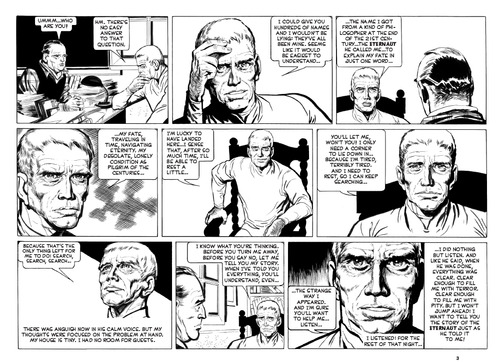The Interrupted Eternity: How the ’70s Argentinian Government Removed Rebel Cartoonist Héctor Germán Oesterheld
Originally serialized between 1957 and 1959 in Hora Cero Semanal, El Eternauta, or The Eternaut, told the story of Juan Salvo, a man displaced in time by an encounter with an alien device. In weekly strips, Juan and his family struggled to uncover the mystery of an awesome snow that fell randomly, killing anyone who came in contact with it. This journey leads to a conflict between humans and aliens, and which ultimately results in Juan’s space-time detachment. A sense of hope underlies the series, and it can be read as the struggle of the everyman to shirk off the yoke of oppression and to circumvent the cycle of slavery that war begets. Salvo is, after all, Spanish for “Save.” He is a savior, and the series’ writer explicitly intended for the character to be a stand-in, an allegorical everyman. The series served, at its heart, as a polemic about the need to dissolve Cold War animosity and to shirk military concerns outweighing democratic ones. The resilience of the people wins the day, not overwhelming military force. But, in a cold twist of irony, The Eternaut’s writer, Héctor Germán Oesterheld, hasn’t been seen since 1977.
Born in Buenos Aires in 1919, Oesterheld was enraptured by science fiction from a young age, writing—in a text that Fantagraphics has included in its reprint of the series released today—that Jules Verne and Robinson Crusoe were particular favorites. He worked first as a journalist before becoming a comic strip writer, but after the end of El Eternauta in 1959 and a series of economic misfortunes, Oesterheld became even more political. In 1968 he went as far as to write a biographical comic of Ché Guevara, which was subsequently banned by the Argentinian government. Working on projects like Dr. Morgue with Alberto Breccia and Sergeant Kirk with Hugo Pratt, Oesterheld cultivated an incredibly rich oeuvre—one of the best kept secrets in comics—and as his career blossomed, his politics were dragged to the fore. His political shift is reputedly evident in the sequel to El Eternauta—El Eternauta Segunda Parte. Though it’s never been available in English, the volume was published in 1976 and is reportedly centered on a futuristic Argentina where a fascist military dictatorship controls the country. This scenario isn’t that fictional for anyone with even a passing familiarity with Argentine politics, and it is overtly political for even the least astute reader. The source of Oesterheld’s conflict with the Argentine government is obvious.
-

-

-

-

-

-

-

-

-

-

-

-

-

-

-

-

-

-

-

-

-

-

-

-

-

-

-

-

-

-

-

-

-

-

-

-

-

-

-

-











































